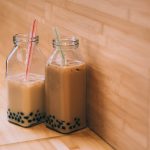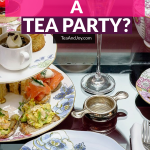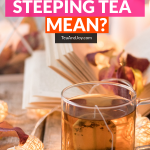There are many variations of Thai tea. The tea itself is a blend of black tea leaves like Ceylon or a locally-grown type of Assam tea plant, mixed with a variety of spices. The spices added may vary depending on the blend, but generally, crushed vanilla bean, cardamom, and star anise are used.
It’s a popular drink, yet few people know what it’s made of, what kind of tea is in it and how it’s prepared.
It can be served hot or cold, and you can add dairy and sweeteners depending on your personal preference. It’s commonly prepared chilled by pouring the freshly brewed blend over crushed ice in a glass (or a plastic bag when you buy it from Thailand’s street carts or side cafes.)
The Thai tea you probably know is the sweet, creamy, orange-colored kind you often see in Thai restaurants in the US. This version tea is actually a cultural hybrid made to appeal to Western tastes. It was invented in America by a chef who based it on the original drink – which had fewer flavorings.
That said, this westernized version has become an iconic beverage symbolizing Thailand’s street food culture in the minds of Western consumers. Other hybrid versions of the beverage came about after that.
Read on to find out more about how this humble beverage became a coveted flavor of its own, what goes into making the original Thai tea drink and other variations, as well as how you can make one for yourself to enjoy.
In this article you'll find:
Who invented Thai tea?
There are a couple of myths regarding how it was invented. Living a tropical country, Thai people preferred cold beverages to fight the heat. Tea was usually prepared hot by the Chinese, so even when Chinese immigrants brought their tea culture to Thailand, it didn’t immediately catch on.
Thailand wasn’t originally a tea-drinking country. It was only around the 1980s when Thailand started commercially growing their own tea, which was imported from China to replace opium as a cash crop.
Some believe that Thai tea as we know it today originated in the 1800s when the country was ruled by King Rama IV. The kingdom had regular interactions with the British and other foreigners and it was then that tea was introduced as a recreational drink.
Servants who were tasked to brew the tea would take the leftover tea leaves and brew them again later. Since the second brew always yields a milder version of the tea, servants learned to add various spices and other supplements to enhance the flavor. There’s limited proof, but it’s believed that the servants’ blended tea version was what inspired it.
Some believe it was during the tea trade between China and India when they expanded their trade route to reach Thailand. Now, Thailand grows a type of Assam tea plant, originally from India, called Bai Miang, which is also used as the black tea base.
Other rumors say that a former Thai leader and prime minister named Plaek Phibunsongkhram was the man who popularized it. Phibunsongkhram had a fondness for Western cuisine and culture. He preferred to have it mixed with milk and sugar, similar to the British. Naturally, he asked his servants to prepare it this way, which is probably how the method spread to the local citizens.
Thai tea caught on among the public and soon, street vendors and cafes started selling it, commonly mixing it with some type of milk and sugar, and then pouring it over crushed ice. Eventually, more versions emerged using different kinds of spices and flavorings, and even artificial coloring!
It’s hard to pinpoint exactly how it came about. One thing’s for sure though: Thai tea as we know it today is likely the product of increased globalization that brought with it various influences from different cultures, each adding their own twist to the iconic Thai beverage.
Who drinks Thai tea?
You may think that it’s a widely celebrated drink in Thailand, but the truth is: not exactly. In reality, it’s just another drink for the locals. It isn’t something locals regularly make at home. You’ll likely encounter it being sold at street carts or cafes, often served in either a glass or plastic bag.
Locals may drink it during their daily commute. Since the weather in Thailand is usually hot, locals prefer to have it poured over crushed ice in a baggie with a straw on the way to work, and so street vendors commonly prepare it this way. It’s rare for a Thai local to sit down and drink Thai tea in a coffee shop or restaurant.
Most people who drink and absolutely love it are tourists, especially Americans. With the rise in tourism, Thai restaurants adapted to their tastes and started preparing it the way Americans preferred them: sweet, creamy, bright orange, and loaded with spices. It’s likely that the food coloring was added to distinguish it from other milky Thai beverages. Americans love it because it complements the super spicy Thai cuisine so well.
This westernized version caused it to gain popularity among foreigners as a quintessential part of Thai street food culture. Some restaurants in the US have even made it into a type of flavor. It’s inspired a ton of desserts in North America like Thai Iced Tea ice cream, Thai Tea creme brulee, and even Thai tea-flavored soft serve with caramelized milk and brown rice!
What is Thai tea made of?
There may be many variations, but all of them will have these two basic ingredients:
- Thai tea blend (a mix of black tea and crushed spices)
- Sugar (regular, brown, or artificial sweeteners)
Some versions may have some type of milk or milk alternative added such as:
- Evaporated milk
- Sweetened condensed milk
- Whole milk
- Rice milk
- Almond milk (or other nut milk)
- Coconut milk
Restaurant-style variations may include:
- Orange blossom water
- Agave nectar
- Mint
- Lime juice
- Lemon rinds
- Rooibos tea leaves
- Lemongrass
- Pandan leaves
Most restaurants will use artificial food coloring to give it its signature orange tinge. However, some restaurants might use natural food colorings such as apricot, safflower or turmeric instead.
Some specialty cafes and restaurants might brew their own blend, mixing black tea with their own choice of spices. Alternatively, they may also use a pre-mixed Thai tea blend and add additional spices to the final beverage. Spices that are commonly used include:
- Cardamom
- Ginger
- Cinnamon
- Vanilla bean
- Tamarind seeds
- Star anise
- Cocoa husks
- Nutmeg
- Cloves
- Cassia bark
The various spices result in a taste similar to chai tea with a slight difference. Chai tea drinkers might even find themselves liking Thai tea!
What kind of tea is in Thai tea?
Strong black tea is the original base. It blends may use either Ceylon or the locally-grown version of Assam called Bai Miang.
Bai Miang is a red-leafed tea plant based on the Indian tea plant grown in Assam. Thai farmers have learned how to cultivate their own variety of Assam that grows under the shade of forests in Thailand.
Ceylon, on the other hand, is tea imported from the highlands of Sri Lanka. Today, it’s seldom used as a base due to its high cost. It was very expensive to ship and import Ceylon tea leaves so most vendors opted for the locally-grown versions instead.
The black tea leaves are then mixed with crushed spices, commonly vanilla bean, star anise, and cardamom. There are many pre-mixed blends sold in bulk. The most prominent brand that sells them is Cha Tra Mue (or Number One Brand), which first started out as a humble Chinese teashop in Bangkok’s Chinatown.
At first, they ran a business that regularly imported oolong and green tea from China. But the Thai locals weren’t known for their fondness for drinking hot tea like the Chinese, mainly because the weather in Thailand was already hot enough! The teashop had to adapt to the locals’ tastes and that’s exactly what they did. They imported red tea used in milk teas and began selling Thai tea beverages served with milk and ice.
Today, Cha Tra Mue sells a proprietary tea blend of crushed spices mixed with black tea leaves. This blend makes up a good portion of all the Thai tea beverages being sold by street vendors, restaurants, and cafes in Thailand.
In essence, the ‘tea’ is actually a mix of these general ingredients:
- Black tea (Ceylon, Bai Miang, or any strong black tea)
- Star anise (or cloves)
- Cardamom
- Vanilla bean
Some blends may even have orange or yellow dyed tea leaves to give the beverage its well-known color.
Why is Thai tea orange?
The orange-colored beverage may actually have originated from America when chefs adopted the traditional recipe and transformed it to appeal to Western tastes – by adding more spices, sugar, and milk in addition to the orange food coloring. The reason may be simply to make the drink stand out. But some believe it may have been added by the servants from the Kingdom of Siam to give the weakened tea a fuller appearance. Who knows?
Whichever is the case, it’s orange because of added artificial (or natural) food coloring. The reason for this is likely to distinguish it from other common tea or coffee beverages. The orange hue also reminds us of popular spicy dishes in Thai cuisine like Tom Yum. It might have been added deliberately to serve as a connection!
How do you make Thai tea?
It’s commonly served iced but can also be served hot depending on your preference. It’s also possible to make your own blended brew at home. Here’s all you need:
- Black tea leaves (either Ceylon, Assam, or any type of black tea)
- Star anise and/or other preferred spices such as:
- Tamarind
- Cardamom
- Cinnamon
Once you have your tea and chosen spices, just steep them all together in boiling water for 5 minutes. After that, simply strain the leaves, and then you have your very own basic version. You may drink it as is or you may use it to make these common variations:
Dark
- Brew Thai tea mix.
- Add sugar (or any sweetener) to taste.
- Pour over ice.
- Serve chilled.
Lime
- Brew Thai tea mix.
- Add sugar (or any sweetener) to taste.
- Pour over ice.
- Add squeezed lime wedge.
- Add mint leaf. (Optional)
Restaurant-style
- Brew Thai tea mix.
- Add milk (condensed milk, evaporated milk, whole milk, or any milk alternative).
- Add sugar (or any sweetener) to taste.
- Add orange food coloring. (Optional)
- Add a drop of vanilla extract. (Optional)
Restaurant-style may sound to you like Thai milk tea. There is a subtle difference which we’ll talk about in the next section.
What does Thai milk tea taste like?
So, what’s the difference between Thai milk tea and restaurant-style Thai iced tea? In truth, they are almost identical. The only difference is that Thai milk tea is served hot or without the crushed ice that Thai iced tea is commonly made with.
In general, Thai milk tea tastes sweeter and smoother. It’s mixed with slightly more milk and sweetener, and the spices aren’t as pronounced as what you would taste in the traditional Dark Thai iced tea.
For some, it’s a more relaxed beverage suited for lounging or sitting down in a coffee shop. On the other hand, Thai iced tea is more suited for people on the go. Do you know which version you prefer?
What is in Thai milk tea?
Thai milk tea is essentially made with the same basic ingredients as Thai iced tea:
- Thai tea blend (black tea leaves mixed with spices)
- Any type of milk (commonly used are evaporated milk or condensed milk)
- Any type of sweetener
Another version of Thai milk tea is called Thai Pearl Milk, which includes black tapioca pearls (also known as boba pearls). The pearls add a nice chewy surprise when sipped with a large straw. Thai Pearl Milk is usually served cool.
What are the other flavors of Thai milk tea?
Generally, milk teas such as bubble milk teas come in many different flavors such as:
- Black milk tea (or Hong Kong milk tea)
- Taro milk tea
- Matcha milk tea
- Fruit milk teas such as:
- Honeydew
- Winter melon (or Chinese melon)
- Strawberry
Thai milk tea is a steady favorite among milk tea lovers, placing it as one of the top milk tea or bubble milk tea flavors. If you’re wondering if there are other variations of Thai milk tea, don’t worry – there are many different ways you can prepare this wonderful beverage. Just remember the base, which is brewed Thai tea blend with sugar to taste. Try out these ideas (measurements are adjusted for one serving):
- Thai Coconut Milk Tea
- Add 1/4 cup canned coconut milk.
- Thai Nut Milk Tea
- Add 1/4 cup almond milk (or any nut milk).
- Thai Vanilla Milk Tea
- Mix 1/8 tsp vanilla extract.
- Add 2 tbsp sweetened condensed milk.
Wrap up
Thai tea may not be as elusive as you previously thought! It’s made with simple ingredients and anyone can make their own version at home. All you need are some black tea leaves, spices, sugar, and milk.
Chai tea lovers will come to enjoy the taste of the many variations due to its black tea base mixed with familiar spices. Try out some pre-mixed blends and see which ones you like.
Orange food coloring is entirely optional when making your own, but if you want to add it in just for fun, go for it! It’s what made the beverage popular among Americans, and most of them will even come to expect the signature bright orange hue when they order in restaurants.
Now that you know what goes into making it and its different versions, you can now make one yourself at home to experience Thailand without buying a plane ticket. Enjoy this refreshing, iconic beverage that has come to symbolize the colorful country and its citizens in the minds of people around the world.




